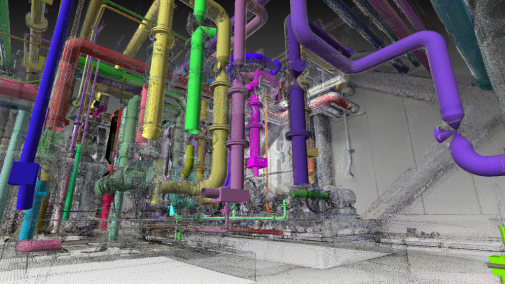Seamless Integration of Point Cloud Data into BIM for Workflow Optimization
Contents |
[edit] Point Cloud and BIM Integration
Point Cloud data and BIM are essential in modern construction. Point Cloud data consists of millions of spatial data points captured from real-world environments using 3D laser scanners or LiDAR. These points create a detailed and accurate digital representation of a physical space. BIM is a process that involves creating a digital model that includes both geometric and functional information of a building.
Integrating Point Cloud data into BIM is crucial for creating accurate and detailed 3D models of existing structures. This process, known as Scan to BIM, converts raw scan data into comprehensive building models. These models support project planning, design, and construction phases. The seamless integration of Point Cloud data into BIM workflows helps improve accuracy, enhance collaboration, and reduce project timelines. This integration leads to better project outcomes and fewer mistakes during construction.
[edit] Benefits of Integrating Point Cloud Data into BIM
The integration of Point Cloud data into BIM brings numerous benefits to construction projects. First, it improves accuracy in building models. Scanners capture every detail of a structure with high precision, which reduces the chance of errors. Accurate models help architects and engineers make informed decisions, avoiding costly mistakes.
Second, Point Cloud to BIM integration enhances collaboration. Project stakeholders, including architects, engineers, and contractors, work with a shared digital model. This shared platform ensures everyone has access to the same up-to-date information. Improved collaboration leads to better communication and smoother project execution.
Lastly, this integration reduces rework and costs. Accurate models highlight potential issues early in the design phase. Addressing these issues before construction begins saves time and money. It also ensures the project stays on schedule, which benefits all stakeholders involved.
[edit] Technologies and Tools for Point Cloud to BIM Integration
Advanced technologies and tools make Point Cloud to BIM integration possible. 3D laser scanning and LiDAR are the primary methods for capturing Point Cloud data. These technologies capture precise measurements and details of a physical environment. They generate millions of data points within seconds, which create a highly accurate digital representation.
Software solutions like Autodesk Revit, Bentley Systems, and Navisworks are commonly used for converting Point Cloud data into BIM models. These programs help transform raw scan data into useful 3D models. They offer features like clash detection, visualization, and detailed analysis. These capabilities support better planning and decision-making.
Automation tools and artificial intelligence (AI) further streamline the integration process. AI algorithms can automatically detect and classify building elements from Point Cloud data. This automation speeds up the modeling process and reduces manual efforts. These tools ensure accurate and efficient integration, making Scan to BIM an essential part of modern construction workflows.

[edit] Workflow Optimization Through Integration
Integrating Point Cloud data into BIM significantly optimizes construction workflows. This integration streamlines the process from design to construction. It helps teams work faster and more efficiently. By using accurate 3D models, project teams can quickly identify issues before construction starts. This early detection of problems prevents costly delays and changes later on.
Point Cloud to BIM integration also enhances project coordination. The digital model provides a clear, detailed view of the project. Teams can see exactly what needs to be done and how different parts fit together. This clarity reduces misunderstandings and improves collaboration. Real-time updates keep everyone on the same page, leading to smoother project execution.
For renovation and retrofitting projects, this integration is especially valuable. It provides a precise representation of existing conditions. This accuracy helps design modifications and adjustments more effectively. The result is a more efficient workflow and a better overall project outcome.
[edit] Applications of Point Cloud to BIM Integration
Point Cloud to BIM integration has diverse applications across various sectors. In residential construction, it helps create accurate models of homes for renovation or new designs. The detailed digital models assist architects in planning and visualizing changes.
In commercial construction, the integration supports complex projects like office buildings and retail spaces. Accurate models help manage large-scale renovations and new builds. They also aid in space planning and optimizing building layouts.
For industrial projects, Point Cloud to BIM integration provides detailed models of factories and plants. It helps in planning machinery placement and facility upgrades. The precise models ensure that changes fit seamlessly into existing structures.
Historic building preservation also benefits from this technology. Point Cloud to BIM helps create accurate models of historic sites. These models assist in maintaining and restoring historical landmarks while preserving their original features.
[edit] Conclusion
Seamlessly integrating Point Cloud data into BIM enhances construction efficiency. Accurate 3D models improve planning and reduce errors. They enable teams to detect problems early and coordinate better. This leads to smoother project execution and fewer delays.
The integration also supports various applications, from residential to industrial and historic projects. It ensures that all changes are accurately reflected in the digital model. This accuracy benefits every phase of the construction process.
Adopting Point Cloud to BIM integration is crucial for modern construction. It streamlines workflows, improves collaboration, and helps deliver better project results. Embracing these technologies ensures that future construction projects are more efficient and successful.
Quick links
[edit] Legislation and standards
Fire Safety (England) Regulations 2022
Regulatory Reform (Fire Safety) Order 2005
Secondary legislation linked to the Building Safety Act
Building safety in Northern Ireland
[edit] Dutyholders and competencies
BSI Built Environment Competence Standards
Competence standards (PAS 8671, 8672, 8673)
Industry Competence Steering Group
[edit] Regulators
National Regulator of Construction Products
[edit] Fire safety
Independent Grenfell Tower Inquiry
[edit] Other pages
Building Safety Wiki is brought to you courtesy of:




